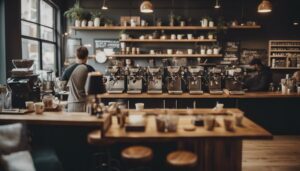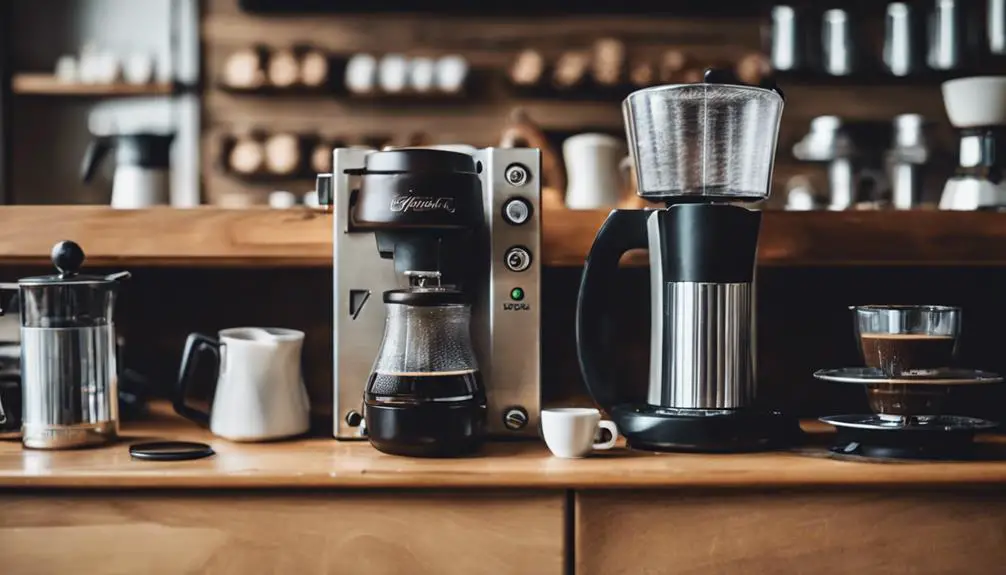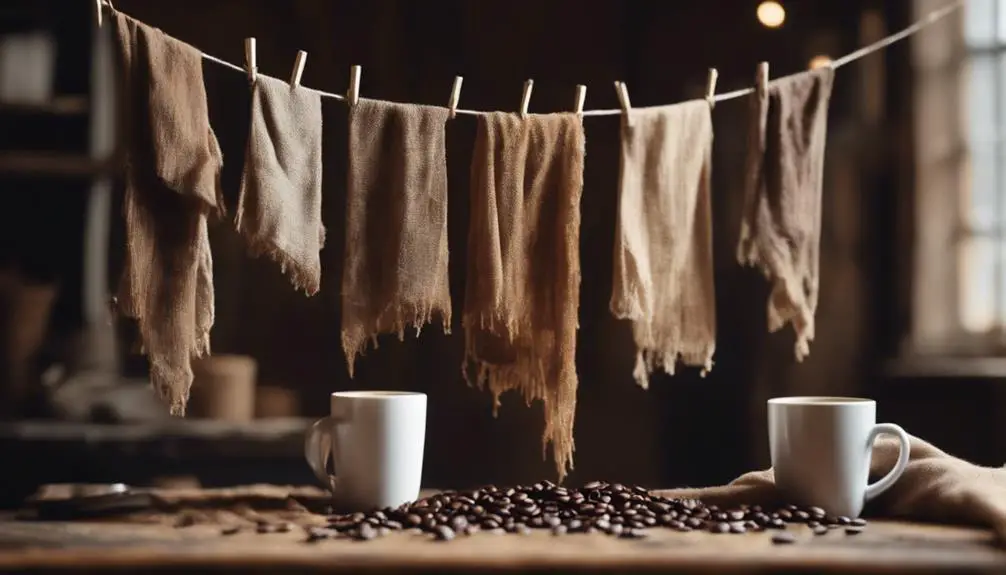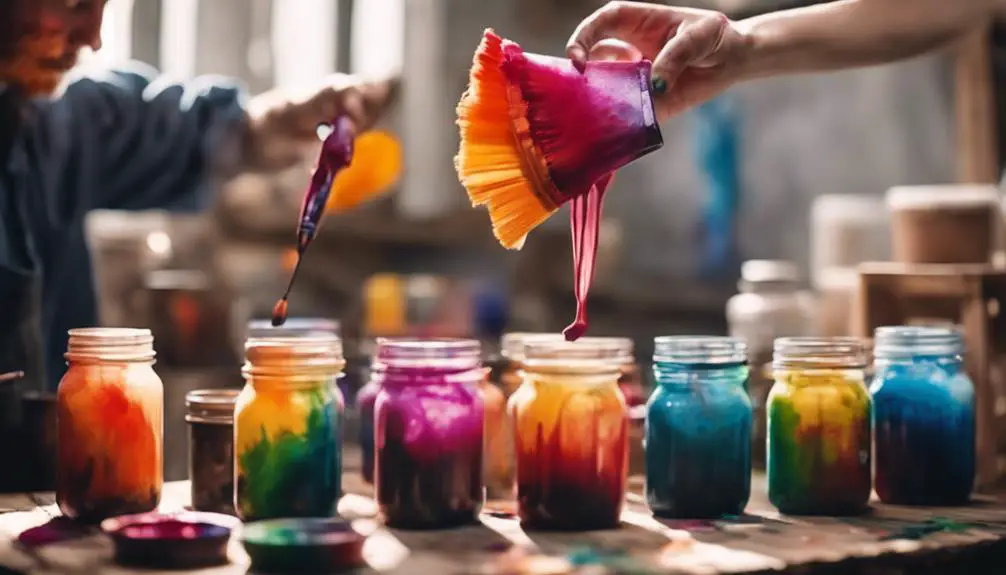Have you thought about your morning cup of coffee’s effect on the earth? Coffee is loved by millions but impacts the planet and its people. Luckily, the coffee industry is making changes. It now focuses on being eco-friendly, helping local areas, and aiming for a sustainable future.
The coffee industry faces many challenges like deforestation and water pollution. Yet, with eco-friendly actions, everyone involved can reduce harm. This includes coffee makers, sellers, and us, the consumers. Together, we can make the coffee world better for all.
We will look at sustainable coffee in detail. We’ll talk about new ways to grow, make, and enjoy coffee. This includes shady farms, organic growing, fair deals, and ethical buys. These changes are to fight climate issues, harm to the earth, and unfairness.
As consumers, we can support these good coffee practices. By choosing wisely and preferring sustainable brands, we help a lot. We can push for better things for those who grow coffee and our planet.
Let’s start this journey. We’ll learn about sustainable coffee and how our choices matter, even with just a cup.
Key Takeaways
- The coffee industry has a large, negative impact on the planet, such as deforestation.
- Its shift to sustainable practices aims to reduce these harms and protect the environment.
- Being eco-friendly helps not only the earth but also local communities and the coffee’s future.
- Consumers can drive real change by picking sustainable coffee options.
- There are creative new ways changing the coffee world for the better.
The Importance of Sustainability in the Coffee Industry
The world wants more coffee, but this demand poses problems. The coffee industry faces big sustainability issues. Climate change, deforestation, water shortages, and waste are key challenges.
To tackle these issues is crucial. It will protect not just the coffee industry but also farmers and our planet.
Using sustainable development in the coffee supply chain protects the earth. It also helps the people and places where coffee grows. Using eco-friendly methods, saving water, and cutting down waste helps a lot.
This way, coffee businesses make life better for farmers and fight poverty. They also make sure we have good coffee in the future.
People care more about how their choices affect the world. Now, they want coffee that’s made the right way. Doing this helps coffee companies. It makes them more popular and beats the competition.
| Sustainability Challenge | Impact on Coffee Industry | Potential Solutions |
|---|---|---|
| Climate change | Reduced crop yields, increased pest and disease outbreaks | Adoption of climate-resilient coffee varieties, agroforestry practices |
| Deforestation | Loss of biodiversity, soil degradation, carbon emissions | Promotion of shade-grown coffee, reforestation efforts |
| Water scarcity | Reduced coffee quality, increased production costs | Implementation of water-efficient irrigation systems, wastewater treatment |
| Waste generation | Environmental pollution, increased disposal costs | Composting of coffee grounds, recycling of packaging materials |
So, sustainability is now very important for the coffee industry. If we all work together, we can use the right methods. This protects the earth, helps farmers, and meets what people want.
This effort can make the future of coffee and the world much better.
Understanding the Environmental Impact of Coffee Production
We are diving into the big world of sustainable coffee. It is very important to know how coffee production affects the environment. Everything from growing the coffee plants to getting the beans ready for sale can hurt nature. We will look at how coffee making can lead to less trees, water problems, and more climate change.
Deforestation and Habitat Loss
Coffee farms often mean fewer trees and fewer types of plants and animals. Why? Because to make room for coffee, people cut down big areas of forests. They often plant just one type of plant, which can harm the soil and lead to problems like soil erosion. This change from diverse, living forests to just coffee fields can badly shake up nature’s balance.
Water Usage and Pollution
Making coffee uses a lot of water and can make water dirty, too. To grow coffee plants, they need plenty of water. After the beans are picked, washing and preparing them also uses water. The water that’s leftover can be bad for the environment if it’s not taken care of. It can mix with things like pesticides and fertilizers, then flow into nearby water, making it hard for fish and sometimes people to have clean water. To make things better, we need to find ways to save water and handle the waste water safely.
Carbon Footprint and Climate Change
Coffee’s impact doesn’t stop with water. Making and moving coffee beans also uses a lot of energy and puts out greenhouse gases. When roasting coffee, a lot of energy is used. And moving beans around the world needs fuel. Plus, cutting down trees for coffee takes away nature’s way of storing carbon. This can make climate change worse. We can lower coffee’s harm by being smarter with energy, planting more trees, and using cleaner power.
Understanding how coffee causes harm is a big first step. We know about the problems of deforestation, water use, and climate change. Now, let’s figure out ways to do better. Farmers can farm in ways that help the land. Factories can make coffee with less water and cleaner ways. And we, as people who love coffee, can choose to drink coffee that’s better for the earth. This is how we work together for a greener coffee world.
Sustainable Farming Practices
Coffee industry folks are making serious changes. They’re turning to eco-friendly ways that are good for our planet. They’re caring for the environment, the people living nearby, and the coffee quality. This move helps reduce harm from old school coffee-making and makes the business stronger for the future.
Shade-Grown Coffee
Shade-grown coffee is a bright star in green farming. It’s called agroforestry. Coffee plants grow under native trees, making a full-on home for many plants and animals. This helps keep nature in balance by saving lots of different species’ homes.
This eco-friendly system also keeps the ground healthy. It stops soil from being washed away and keeps good nutrients moving. The trees protect the soil, their leaves feed it, and so the coffee plants are tough and make really great beans. This means they need less work and produce high-quality beans.
Organic Farming Methods
Organic farming is another important step for green coffee. No chemical pesticides or fertilizers are used. Organic farms are all about the natural stuff. They use compost, cover crops, and mulch to keep the land and the coffee happy and healthy.
- Composting: Using organic waste materials to create nutrient-rich soil amendments
- Cover cropping: Planting beneficial crops between rows of coffee plants to suppress weeds, fix nitrogen, and prevent erosion
- Mulching: Applying organic matter to the soil surface to retain moisture, regulate temperature, and suppress weed growth
- Integrated pest management: Employing a combination of biological, cultural, and physical controls to manage pests and diseases without relying on synthetic chemicals
Going organic means working with nature instead of against it. It builds a farm that can last a long time. This kind of farming is good for the coffee and everything around it.
Soil Conservation and Regeneration
Healthy soil is critical for great coffee. Farmers protect and renew the soil to face climate change and other challenges. There are smart ways to look after the ground:
| Technique | Description | Benefits |
|---|---|---|
| Terracing | Creating level steps on steep slopes to reduce erosion and improve water retention | Prevents soil loss, conserves moisture, and increases crop yields |
| Contour planting | Planting crops along the contours of a slope to slow water runoff and reduce erosion | Minimizes soil disturbance, improves water infiltration, and enhances soil stability |
| Agroforestry | Integrating trees and other perennial plants into the coffee farming system | Enhances soil structure, increases organic matter, and promotes nutrient cycling |
Investing in soil saves the future of coffee making. So farms stay strong and fruitful for many years ahead. The more we want green coffee, the more these caring practices matter. They are key to the industry’s long life and the joy of the people it supports.
Fair Trade and Ethical Sourcing
In the world of coffee, fair trade and ethical sourcing are vital. They help the well-being of farmers. They also keep the industry strong. Fair trade supports small farmers. It makes sure they get fair prices. Coffee companies in these programs can help farmers live better.
Ethical sourcing is a big deal in coffee too. It looks at transparency and building long-term relationships. These practices make a better life for those who grow coffee. They also make sure the coffee we buy helps the farmers.
Fair trade and ethical sourcing fight against unfairness in coffee trading. Small farmers often live in poverty because of low prices. These ways help by ensuring fair pay and funding community projects.
| Conventional Coffee | Fair Trade Coffee |
|---|---|
| Farmers receive market prices, which can be volatile and low | Farmers receive a guaranteed minimum price, protecting them from market fluctuations |
| Limited transparency and traceability in the supply chain | Increased transparency and traceability, allowing consumers to know the origin of their coffee |
| Focus on short-term transactions and price | Emphasis on long-term partnerships and community development |
| Farmers have limited bargaining power and access to resources | Farmers are empowered through democratic decision-making and access to resources |
As customers, we can help by choosing coffee that’s fair trade or ethically sourced. This support ensures a better future for coffee farmers. It means our coffee does more than just taste good. It also helps those who grow it live better.
Sustainability in Coffee Processing and Roasting
The journey to sustainable coffee shows how important every step is. Each part, from growing to brewing the bean, impacts the earth. The stages of processing and roasting need a lot of energy. This uses a lot of energy and can cause harm. But, by using new tech and methods that care for the earth, we can make a big difference.
Energy-Efficient Roasting Methods
Switching to smart ways to roast coffee helps the planet. Often, roasting uses up lots of fossil fuels, sending harmful gases into the air. Good roasters now choose solar or wind power for a cleaner process. Making roasting places keep heat better also helps. This way, less energy gets used, which is good for the earth.
Waste Reduction and Recycling
Cutting down on waste and reusing materials is key. Smarter water use, like turning water back in on itself and using mild machines, is a big help. It saves water and protects the planet. Also, turning old coffee and other waste into soil food helps farmers grow better crops.
Recycling also matters a lot, especially for coffee packages. Many now pick bags and wraps that can go in the compost or be recycled. Some even reuse the coffee bags. This cuts down on trash and helps the world breathe better.
| Sustainable Practice | Environmental Benefit |
|---|---|
| Renewable energy sources for roasting | Reduces carbon emissions and reliance on fossil fuels |
| Improved insulation in roasting facilities | Conserves energy and minimizes heat loss |
| Water-efficient processing methods | Reduces water consumption and helps preserve water resources |
| Composting coffee grounds and organic waste | Diverts waste from landfills and creates nutrient-rich soil amendment |
| Recyclable or compostable packaging materials | Minimizes packaging waste and reduces environmental pollution |
Single-serve coffee pods are a big problem for the planet. They’re handy but make a lot of trash. Companies are making pods that don’t hurt the earth. Plus, they’ve started to recycle or refill these pods. This helps reduce how much waste these pods make.
I love coffee and seeing new ways that we can make it that don’t harm our planet excites me. Every choice we make in making and enjoying coffee can help our planet. So, let’s toast to a greener future with every cup we drink.
Eco-Friendly Packaging and Distribution
We care about the earth and want eco-friendly coffee packaging and distribution. This helps coffee companies lower their waste. It makes our future greener.

Biodegradable and Compostable Materials
Using materials that break down easily is key to less packaging waste. Things like plant-based plastics and paper with water-based coatings help. They don’t harm oceans and reduce landfill trash.
Bagasse, from sugarcane, is great for making cups and containers. All these choices help the planet. Coffee sellers can show they care and attract more customers.
Reducing Transportation Emissions
It’s important to ship coffee in ways that don’t hurt the air. Businesses can do several things:
- Make shorter shipping routes
- Use green cars or other eco-friendly ways to move coffee
- Send products together to cut down on trips
- Buy from nearby places to help the local economy and the planet
These actions cut pollution and get coffee to customers on time.
| Packaging Material | Biodegradability | Compostability | Environmental Impact |
|---|---|---|---|
| Plant-based plastics | High | High | Low |
| Paper-based packaging | High | High | Low |
| Bagasse | High | High | Low |
| Traditional plastics | Low | Low | High |
Coffee companies can also look to reusable options. They can use circular economy ideas, too. This includes taking back coffee bags or cups. It reduces waste and helps the planet.
With green practices, the coffee industry can improve a lot. We, as buyers, can support them. Choose brands that are eco-friendly and work to reduce waste.
The Role of Consumers in Supporting Sustainable Coffee
Consumers like me can help the sustainable coffee industry a lot. We do this by buying eco-friendly and ethical coffee. This tells coffee businesses we care about the planet and people. So, I try to pick coffee that’s good for the Earth and fair to farmers.
I check for certifications like Rainforest Alliance, USDA Organic, and Fair Trade on my coffee. These show it was made using good practices and that farmers got paid fairly. It helps me choose coffee that matches my values.
I also do things to use coffee in a better way every day. I use a reusable cup, recycle or compost my coffee packaging, and try not to waste food at cafes. These small steps help the planet and support sustainable coffee.
| Action | Impact |
|---|---|
| Choose certified sustainable coffee | Supports eco-friendly farming practices and fair compensation for farmers |
| Use reusable cups | Reduces waste from disposable cups and lids |
| Recycle or compost coffee packaging | Diverts waste from landfills and reduces environmental impact |
| Reduce food waste at coffee shops | Conserves resources and minimizes unnecessary waste |
Lastly, I can help spread the word about sustainable coffee. By talking to others, I can get them interested in eco-friendly coffee too. This way, we can all help make coffee better for the planet and people.
Certifications and Labels for Sustainable Coffee
Consumers now know the impact of their buy choices on the planet. Certifications and labels help find sustainable coffee. They make sure the coffee meets set environmental and social rules. When you choose these coffees, you help with saving nature, use of natural farming, and fair pay for farmers.
Rainforest Alliance Certification
The Rainforest Alliance sets a high bar for coffee and other farm products. It checks if farms keep nature safe, cut down on water pollution, and treat workers right. So, buying this type of coffee means you’re helping the environment and the farmers.
USDA Organic Certification
The USDA Organic seal means no harmful pesticides or GMOs are used in the coffee. Growing coffee in an organic way is about taking care of the land and its many plants and animals. Picking USDA Organic Certified coffee supports these good farming ways.
Bird-Friendly Certification
The Bird-Friendly seal comes from the Smithsonian Institute. It focuses on shade-grown farms that keep birds and plants safe. These farms have many native trees that birds need. Choosing Bird-Friendly coffee helps in keeping bird homes and coffee lands healthy.
In addition to these certifications, there are several other labels and standards that promote sustainable coffee production, such as:
- Fair Trade Certified
- 4C (Common Code for the Coffee Community)
- UTZ Certified
- Shade Grown or Shade Cultivated
Knowing about these labels helps shoppers pick the right coffee. Choosing certified coffee means you stand with the earth and the people making the coffee.
Innovations and Future Trends in Sustainable Coffee Production
The world of sustainable coffee production is always changing. New tech and trends help overcome industry challenges. These include precision farming, soil checks, saving water, and using clean energy.
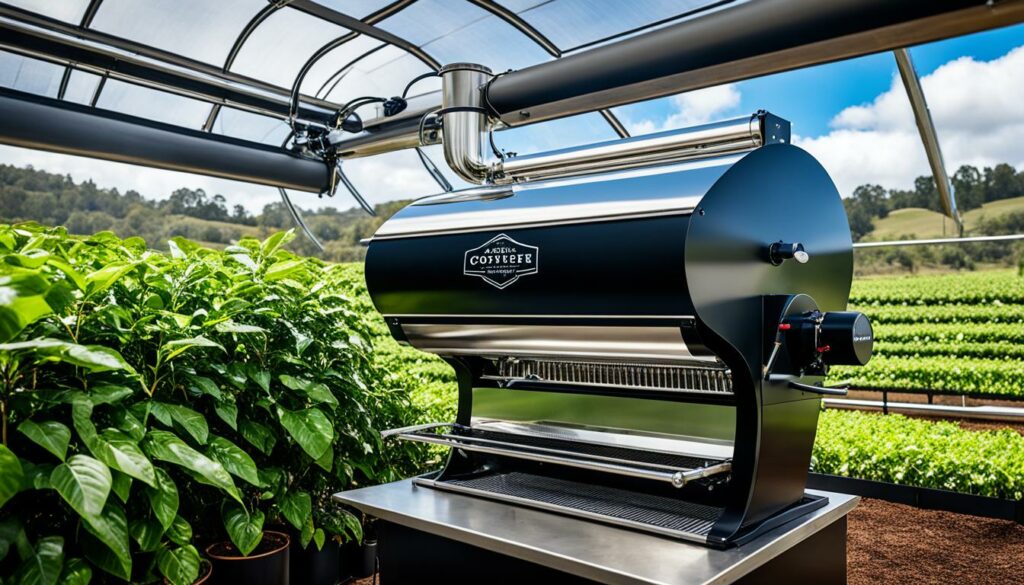
Using technology for better resource use and yields is a major advance. Tools like satellite images and drones give farmers valuable crop data. This helps them use water, fertilizer, and pest control more wisely. It leads to less waste and higher quality coffee that’s better for the planet.
Creating coffee plants that can weather climate change is another key point. As the earth gets hotter and weather gets weirder, we need tough, tastier coffee plants. This takes heavy research and choosing just the right plant mixes.
Blockchain tech is also finding its way into the coffee chain. It makes tracking coffee from seed to sip tamper-proof and trustworthy. This proves if your coffee is really eco-friendly. It also ensures fair pay for those who grow it, building consumer trust.
| Innovation | Benefits |
|---|---|
| Precision agriculture | Optimizes resource use, reduces waste, improves crop yields |
| Climate-resilient varieties | Withstand challenges posed by climate change, increase productivity and flavor |
| Blockchain technology | Enhances traceability and transparency, verifies sustainable practices, supports fair pricing |
Looking ahead, regenerative farming is gaining more focus. It aims to bring back the land’s health and life. This can cut the bad effects of coffee farming and help nature flourish. Things like planting more trees, using diverse crops, and making natural fertilizers can make coffee farms stronger and greener over time.
Collaborations and Partnerships for Sustainability in Coffee
Collaborations and partnerships are powerful in the complex coffee industry. They bring diverse groups together. This includes everyone from producers to sellers and NGOs. They share knowledge and practices, creating new solutions. These benefit everyone involved in making and selling coffee.
Industry Initiatives and Organizations
Working together is key for a sustainable coffee industry. Producers, roasters, retailers, and NGOs join forces. They share skills and views, creating whole solutions. These deals with their unique issues. Important groups include:
- The Sustainable Coffee Challenge, which brings over 150 parties to make coffee the globe’s first sustainable crop.
- The Global Coffee Platform is a group that gets everyone talking and working for a healthy coffee future.
- The Specialty Coffee Association’s Sustainability Council supports green standards and good ways in the coffee world.
Research and Educational Programs
Learning and research programs help coffee grow in a sustainable way. They cover many topics, like dealing with climate change. They create new ideas and tools for everyone in the coffee business to use. Here are a few examples:
- World Coffee Research works to make more and better coffee, improving the lives of those who grow it.
- The Sustainable Agriculture Network sets green standards and teaches ways for farmers and others in the coffee line.
- The Coffee Quality Institute helps make coffee places better for women, providing education and support.
These programs also help coffee growers and others learn new things. They get training and resources to improve their work. This supports the use of the best methods. It makes coffee-making more sustainable and stronger against challenges.
| Type of Collaboration | Key Benefits | Examples |
|---|---|---|
| Industry Initiatives | Facilitate dialogue, alignment, and action towards common sustainability goals | Sustainable Coffee Challenge, Global Coffee Platform |
| Research Programs | Generate new knowledge and tools to support sustainable production practices | World Coffee Research, Sustainable Agriculture Network |
| Educational Programs | Build capacity among farmers and promote the adoption of best practices | Coffee Quality Institute’s Partnership for Gender Equity |
Key to the coffee world’s future is working together. Each part, from grower to buyer, brings something special. They create smart solutions that help everyone. As coffee keeps changing, strong partnerships are crucial. They ensure a good future for coffee.
The Benefits of Sustainable Coffee for Farmers and Communities
Sustainable coffee is good for farmers and their towns. It helps by using eco-friendly ways and fair trade rules. This makes life better, keeps the economy strong, and helps society grow in coffee areas. Let’s see how growing coffee right can change lives.
Improved Livelihoods and Economic Stability
Sustainable coffee helps farmers make more money. It offers fair prices so farmers can cover their costs and still save. With this, farmers can improve their farms and grow their businesses. They can also earn money by planting other crops along with coffee. This helps them survive tough times when the market or weather is bad.
Empowerment and Social Development
Sustainable coffee is good for more than just making money. It focuses on making society better for everyone, especially women. Programmes help women and others get educated, stay healthy, and have a say in their community’s future. This makes communities stronger and happier for all.
Sustainable coffee also fights poverty and ensures food is always there. When farmers make good money, they can grow more food for their families. They can also afford better health and education. This brings long-lasting benefits to their areas. By choosing sustainable coffee, we all help make these good things happen.
| Sustainable Coffee Practice | Benefit for Farmers and Communities |
|---|---|
| Fair Trade Certification | Ensures farmers receive fair prices for their coffee, improving income stability and living standards |
| Organic Farming Methods | Protects farmer health by eliminating exposure to harmful pesticides and promotes long-term soil fertility |
| Access to Credit and Financial Services | Enables farmers to invest in farm improvements, expand operations, and build financial resilience |
| Gender Equality Initiatives | Empowers women in coffee-growing communities, promoting inclusive decision-making and social development |
| Education and Healthcare Programs | Improves access to quality education and healthcare, enhancing the well-being of farmers and their families |
Supporting sustainable coffee makes a better world for farmers and their towns. As buyers, we can choose coffee that helps people and the planet. Our actions can change lives. Let’s make sure everyone along the coffee’s journey benefits.
Conclusion
Using sustainable coffee and eco-friendly practices is very important. It helps deal with the challenges the coffee industry faces. These problems are about the environment, being socially responsible, and staying economically stable. We want to make sure coffee has a good future.
We, as people who enjoy coffee, can make a difference. It’s by choosing coffee that was made the right way. This means looking for coffee that comes from responsible farms. We can make a big impact by doing this.
But, making the coffee world better needs all of us to work together. This includes companies, farmers, and even us, the customers. It’s all about helping each other and the planet. If we all do our part, coffee can keep growing for many years.



